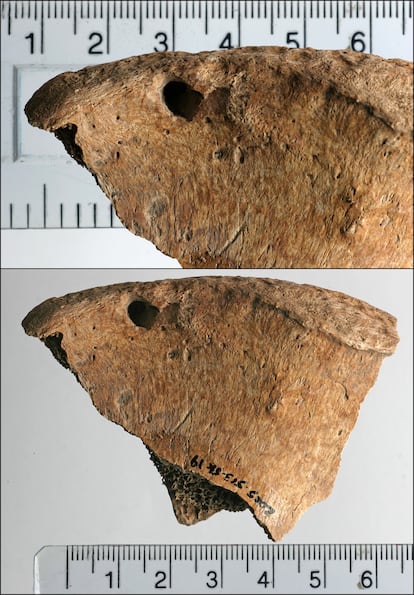A lion bite on the remains of a Roman gladiator: The first direct evidence of combat with animals
Until now, these clashes in the arenas of the empire were only known from written records and artistic representations
They were called venatores. They were a specialized type of gladiator who, from the 1st century BC onward, fought in the arenas of the Roman Empire against wild animals. Bears, leopards, lions, and deer faced off against men armed with swords, spears, and whips, providing a bloody spectacle for the masses. Until now, this was known mainly from written records and the scenes immortalized on large mosaics found from Libya to Tunisia. Images of this savage struggle are evident. But new research published Wednesday presents the world with the first skeletal evidence of a gladiator bitten by a lion in the Roman period.
Archaeologists from several universities — including Maynooth University in Ireland and King’s College London — extracted a human skeleton from what is believed to be a gladiatorial cemetery outside York, in the United Kingdom. After several analyses, the researchers concluded that distinctive marks on the deceased’s pelvis are, in fact, the teeth of a lion.
“We believe these are the remains of a gladiator who faced the feline in a combat arena as part of a Roman spectacle,” says Tim Thompson, professor of anthropology and lead author of the study, published in the journal PLOS One. “This discovery provides the first direct physical evidence that gladiatorial combats and spectacles featuring animals took place, which redefines our perception of Roman entertainment culture in the region.”

The skeleton is that of a man aged between 26 and 35 who was buried in a tomb with two other people covered with horse bones. The gladiator died from the bite wounds of the feline and was subsequently decapitated, although the exact reason is unknown. The marks on this individual’s pelvis were compared with bite marks from large animals, mainly carnivorous predators, and matched those of a lion taken in a zoo.
“What surprised us most was that we are talking about a lion in Britannia [the name the Romans gave to the province that occupied the center and south of what is now Great Britain], so now we want to know not only about the spectacle itself, but also how the Romans obtained that lion, how they brought it from Africa to Europe, and then to York,” Thompson explains.
John Pearce, a doctor in archaeology who also participated in the research, has some theories on this. “The first thing to know is that at that time, animals were primarily used for two purposes,” he writes in an email from London. First, predators faced off against certain types of gladiators, or even against each other. For example, a bull against a bear. And second, they were executioners in public executions of prisoners and criminals.
“This ‘spectacle’ was known as damnatio ad bestias [condemnation of the beasts], in which the victim was tied up or thrown unarmed into a cage to face the animals,” Pearce notes. This can be clearly seen in a Roman mosaic from the late 2nd century BC preserved in the Archaeological Museum of El Djem in Tunisia.
A test against skepticism
While some remains of Roman amphitheaters still survive in Britain, there is very little specific evidence that reveals what actually happened inside them.
“There has been speculation that human-animal combat took place, with animals that may have been bred or captured in the region, such as bulls or bears. But before the new analysis, most researchers were highly skeptical of the idea of felines in arenas in Britannia,” Pearce notes.
Transporting these animals in good condition across continents presented a huge logistical challenge. But it seems the Romans were experts.

The archaeologist explains that places like York, with a significant legionary stronghold, were connected to continental Europe by land and water routes. The roads were used to transport goods such as grain, wine, and olive oil to supply the armies spread across the region.
“After being captured — probably in North Africa — animals such as lions and leopards were transported by sea to Italy. Their movement to northern Europe was probably supported by military routes, using carts and ships,” Pearce explains.
The great challenge in this type of transport was keeping the animals alive and fit to fight. The expert explains that it is likely that the big cats were transported in cages and crates, with a huge amount of manpower required to care for them. Despite these precautions, these animals had a high mortality rate due to the stress of the journey. Pearce points out that “some animals could be more docile if captured as young animals and accustomed to human presence, although this also hindered aggressive behavior in the arena unless they were starved or provoked.”
Both co-authors say their research “constitutes crucial evidence to demonstrate that this type of traditional Roman spectacle took place even in the most remote regions of the empire.” They add that a lion or leopard was likely a great novelty and an effective piece of theater. However, they add, they still need to gather more evidence to understand how frequently these events occurred and what their role and impact were in popular culture.
Sign up for our weekly newsletter to get more English-language news coverage from EL PAÍS USA Edition
Tu suscripción se está usando en otro dispositivo
¿Quieres añadir otro usuario a tu suscripción?
Si continúas leyendo en este dispositivo, no se podrá leer en el otro.
FlechaTu suscripción se está usando en otro dispositivo y solo puedes acceder a EL PAÍS desde un dispositivo a la vez.
Si quieres compartir tu cuenta, cambia tu suscripción a la modalidad Premium, así podrás añadir otro usuario. Cada uno accederá con su propia cuenta de email, lo que os permitirá personalizar vuestra experiencia en EL PAÍS.
¿Tienes una suscripción de empresa? Accede aquí para contratar más cuentas.
En el caso de no saber quién está usando tu cuenta, te recomendamos cambiar tu contraseña aquí.
Si decides continuar compartiendo tu cuenta, este mensaje se mostrará en tu dispositivo y en el de la otra persona que está usando tu cuenta de forma indefinida, afectando a tu experiencia de lectura. Puedes consultar aquí los términos y condiciones de la suscripción digital.
More information
Últimas noticias
The metaverse, four years later: Is it finished or just at a standstill?
$3,000 and a plane ticket: The United States increases incentives for migrants to self-deport before the end of the year
Charles Dubouloz, mountaineering star, retires at 36 with a farewell tour inspired by Walter Bonatti
From the White House to diplomatic gifts: Lego wins over adult fans, brick by brick
Most viewed
- Families demand repatriation of bodies of Colombians who died in Ukraine: ‘This war is a slaughterhouse for foreigners’
- The low-cost creative revolution: How technology is making art accessible to everyone
- Liset Menéndez de la Prida, neuroscientist: ‘It’s not normal to constantly seek pleasure; it’s important to be bored, to be calm’
- Christian Louboutin: ‘Young people don’t want to be like their parents. And if their parents wear sneakers, they’re going to look for something else’
- Christmas loses its festive spirit: ICE fears cast shadow over religious celebrations










































